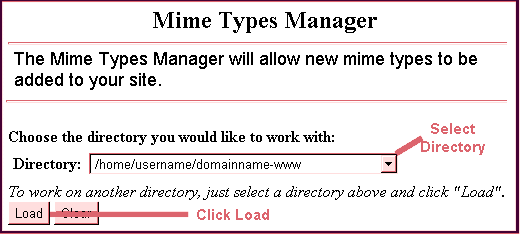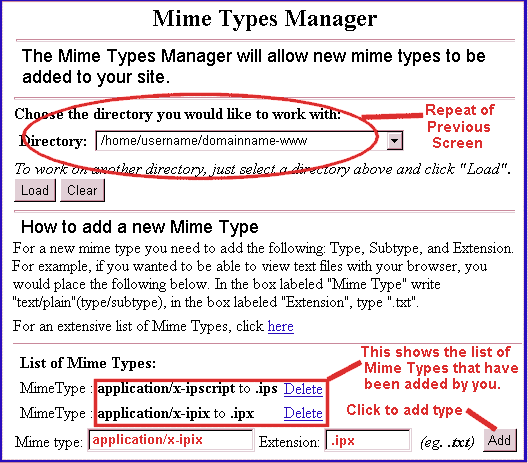Account Overview
Chapter 2
Getting Started
Chapter 3
Control Panel Overview
Chapter 4
FTP Instructions
Chapter 5
SSH / Telnet
Chapter 6
Email Software Setup
Chapter 7
File Manager
Chapter 8
Change Password
Chapter 9
Mail Manager
Chapter 10
Site Statistics
Chapter 11
Mailing List
Chapter 12
Microsoft FrontPage
Chapter 13
Site Creation Tool
Chapter 14
Counters
Chapter 15
Protect Directories
Chapter 16
Redirect URL
Chapter 17
Search Engine
Chapter 18
Formmail
Chapter 19
PGP & PGP Mail
Chapter 20
Mime Types
Chapter 21
Anonymous FTP
Chapter 22
Archive Manager
Chapter 23
SSL (Secure Server)
Chapter 24
MySQL
Chapter 25
Shopping Cart
Chapter 26
CGI-bin
Chapter 27
Real Audio / Real Video
Chapter 20 - Mime Types
Explanation of Mime Types
This feature is not available for FrontPage users, any Mime types needed FP users will have to be added using FrontPage.
The MIME Types option in your Control Panel allows you to set certain programs to be used for specific extensions.
In easier-to-understand terms, MIME Types helps your web server to identify what type of file is being requested by your browsers. For instance, when the web server gets a request from a browser such as Internet Explorer or Netscape, for a file that ends in .html, the web server knows that it is an html document because that extension is stored in the Mime Type. If the web server gets a request from a browser for a file that ends in .gif, the web server knows that it is an image because that too is stored in the Mime Types. This applies to every file, image, application, etc. that may be requested by a web browser. If the extension is not stored within the Mime Type, the web server will not recognize it and will not be able to assist the browser and that particular file type will not be viewable by the user.
Mime types are identified by the server by the following format:
subtype/type extensionFor example adding the following two Mime Types will allow users to view ipx images on your web pages:
application/x-ipscript .ips application/x-ipix .ipxapplication identifies the subtype, x-ipscript identifies the application, and .ips identifies the extension used for that application.
For more information on Mime Types you can visit http://www.qnx.com/~chrish/Be/info/mime-types.html
How to Add Mime Types
Click on the Mime Types option in your Control Panel and you will be taken to the following window. Select the directory in which you want the new Mime Type to apply to, the most common choice would be your www directory so that it will apply to your entire web site.

The next window you will be taken to (see the following screenshot) is where you will actually add the Mime Type. We've added instructions in red.
